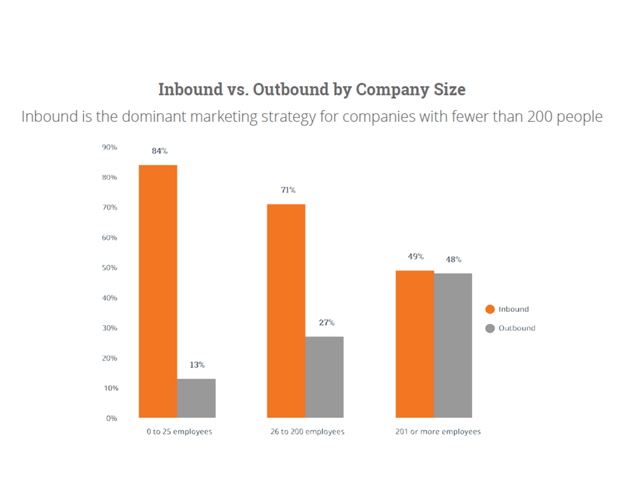 A few weeks ago, the Inbound Marketing software and management firm HubSpot released their annual State of Inbound Marketing report (link fixed).
A few weeks ago, the Inbound Marketing software and management firm HubSpot released their annual State of Inbound Marketing report (link fixed).
Given that this is the time of year when many firms are setting budgets for their investment management marketing strategy for 2016, examining exactly what is happening with Inbound, how its impact is being felt, and what we can expect going forward is apropos.
The Report
Here are a few key takeaways from the larger report:
- 3 out of 4 marketers across the globe prioritize an Inbound approach to marketing.
- Both Inbound and outbound marketers rank paid advertising as the most overrated marketing tactic.
- Proving marketing ROI unlocks budget - unfortunately, tracking ROI in a systematic, repeatable manner has yet to become a standard practice.
- Leading marketers recognize that Inbound is a long game. Both past success and past failure with Inbound correlates with changes in a company's marketing budget.
- Inbound tactics are one of the most preferred marketing strategies across all B2B, B2C, & nonprofit industries.
- Inbound campaigns achieve higher ROI than outbound. This holds true across different company sizes and budgets.
The Methodology
After surveying nearly 4,000 respondents, the report examines the current state of the Inbound Marketing industry, and offers marketers data, analytics, and other observations about how Inbound Marketing is perceived, planned, executed, and analyzed across a broad cross-section of industries.
Of relevance to many investment managers & money managers:
- 65% of respondents came from B2B industries.
- 69% reported annual revenues of between $0 & $10 million.
- 64% were not HubSpot customers.
While it does not perform a deep dive into the efficacy of Inbound Marketing for investment managers specifically, it does include Financial Services as a whole, and thus there are there are a number of lessons to be learned & applied.
As HubSpot writes in their introduction,
“… HubSpot surveys thousands of the world’s foremost marketers and salespeople -- HubSpot customers and non-customers alike. We poll them on their most pressing priorities, the challenges they face, and the tactics they’ve used to meet those challenges head-on. We track our respondents’ quantitative answers, collate and consolidate their anecdotal answers, and put the polished result into a master report: State of Inbound.”
Because of the peculiarities unique to the asset management industry, sweeping generalizations about how the data in the report applies to investment management marketing should be tempered.
However, I think it is important to acknowledge that, in other ways, investment management firms aren’t nearly as insulated from broader trends as it may seem.
The Growth of Inbound


Looking at a sampling of the study’s graphs, we can see a couple of compelling statistics:
- In companies with 1-25 employees, 84% use Inbound
- Those with 26-200? 71%
- Among these firms, proving ROI and securing a sufficiently hefty budget are among the most important concerns.
- Once ROI has been established, 67% of companies reported higher marketing budgets the following year.
As the report's authors state,
“The key here…is to track ROI in the first place in order to prove ROI and justify a budget increase. No ROI tracking, no demonstrable ROI. No ROI, no budget.”
Trends
So where are things heading? The report revealed a few surprising findings:
- Companies are worried about increasing leads and conversions, but not the cost of doing so. This was, personally one of the more surprising findings.
- Finding an executive sponsor and training teams are priorities which are increasing in importance.
- Even outbound marketers say outbound marketing is overrated.
- Inbound has demonstrated widespread success across B2B, B2C, and nonprofit sectors.
- Senior executives favor inbound more than managers.
- More marketers are sourcing content from outside their company – in other words, hiring firms such as DQCOMM to handle their content generation, distribution, & analytics.
Past Results = Future Budgets
Across the board, Inbound Marketing is understood to deliver higher ROI than outbound, irrespective of company size, industry, or total marketing budget.
In practical terms, this means marketing executives and managers are increasingly resistant to the siren’s song of paid campaigns. They are coming to terms with the fact that traditional outbound marketing is losing its lustre.
So what are a few best practices employed by those who implement Inbound & are finding success?
- Best-in-class marketers maintain a close eye on analytics.
- They also carefully track ROI & are able to produce analytics which demonstrate the efficacy of Inbound Marketing. When they do so, marketing budgets grow year-over-year.
- In addition, content is produced by internal staff, outside agencies, and guest contributors in order to create a vibrant, multi-faceted library of marketing content.
Automate for Success
One of the most important tools in the arsenal of Inbound Marketers is a platform (such as Hubspot’s, not coincidentally) for automating their team’s marketing efforts.
The companies which enjoyed the highest marketing ROI in 2014 were the ones most likely to have employed marketing automation software in their efforts:

Not surprisingly, based on what we’ve notes earlier, those same respondents were more likely to see higher budgets unlocked as a result, and virtually none saw their budgets cut.
The Point?
Whether it’s Inbound Marketing for asset managers, financial planners, private equity firms, or hedge funds, Inbound Marketing for money managers of all stripes is coming.
And while Inbound Marketing for investment management firms has yet to become standard practice in the industry, it makes sense to begin adding an Inbound Marketing component to your existing efforts.
Next week, I’ll review the Inbound Sales component of the report.
Happy Thanksgiving!


